Humminbird 550, 561 DI, 561, 560, 570 Owner's Manual
...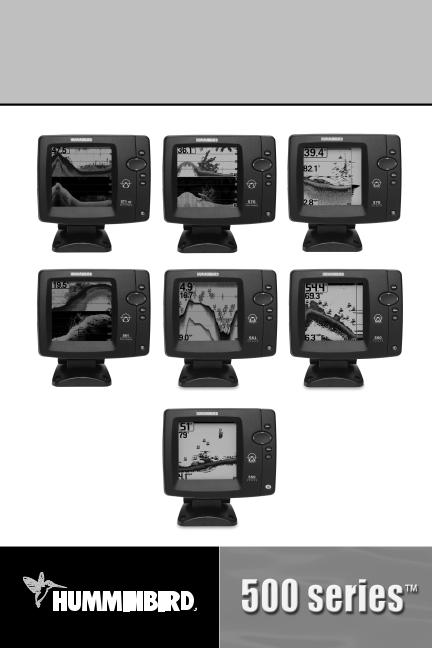
550, 560, 561, 561 DI, 570, 570 DI, and 571 HD DI Operatiions Manual
531716-5EN_A

Thank You!
Thank you for choosing Humminbird®, the #1 name in fishfinders. Humminbird® has built its reputation by designing and manufacturing top-quality, thoroughly reliable marine equipment. Your Humminbird® is designed for trouble-free use in even the harshest marine environment. In the unlikely event that your Humminbird® does require repairs, we offer an exclusive Service Policy - free of charge during the first year after purchase, and available at a reasonable rate after the one-year period. For complete details, see the separate warranty card included with your unit. We encourage you to read this operations manual carefully in order to get full benefit from all the features and applications of your Humminbird® product.
To contact our Customer Resource Center, call 1-800-633-1468 or visit our Web site at humminbird.com.
WARNING! This device should not be used as a navigational aid to prevent collision, grounding, boat damage, or personal injury. When the boat is moving, water depth may change too quickly to allow time for you to react. Always operate the boat at very slow speeds if you suspect shallow water or submerged objects.
WARNING! Disassembly and repair of this electronic unit should only be performed by authorized service personnel. Any modification of the serial number or attempt to repair the original equipment or accessories by unauthorized individualswill void the warranty.
WARNING! This product contains chemicals known to the State of California to cause cancer and/or reproductive harm.
WARNING! Do not travelat high speed with the unit coverinstalled.Remove the unit cover before traveling at speeds above 20 mph.
NOTE: Some features discussed in this manual require a separate purchase, and some featuresare only available on international models. Every efforthas been made to clearly identify those features. Please read the manual carefully in order to understand the full capabilities of your model.
NOTE: To purchase accessories for your control head, visit our Web site at humminbird.com or contact our Customer Resource Center at 1-800-633-1468.
NOTE: The procedures and features described in this manual are subjectto change without notice. This manual was written in English and may have been translated to another language. Humminbird® is not responsible for incorrect translations or discrepancies between documents.
NOTE: The illustrations in this manual may not look the same as your product,but your unit will function in the same way.

ROHS STATEMENT: Product designed and intended as a fixed installation or part of a system in a vessel may be considered beyond the scope of Directive 2002/95/EC of the European Parliament and of the Council of 27 January 2003 on the restriction of the use of certain hazardous substances in electrical and electronicequipment.
ATTENTION INTERNATIONAL CUSTOMERS: Products sold in the U.S. are not intended for use in the international market. Humminbird® internationalunits provide international features and are designed to meet country and regional regulations. Languages, maps, time zones, units of measurement, and warranty are examples of features that are customized for Humminbird® international units purchased through our authorized international distributors.
To obtain a list of authorized international distributors, please visit our Web site at humminbird.com or contact our Customer Resource Center at (334) 687-6613.
500 Series™, Down Imaging™, DualBeam PLUS™, Fish ID+™, Humminbird®, RTS™, RTS Window™, Structure ID®, SwitchFire™, WhiteLine™, and X-Press™ Menu are trademarked by or registered trademarks of Johnson Outdoors Marine Electronics, Inc.
Baekmuk Batang, Baekmuk Dotum, Baekmuk Gulim, and Baekmuk Headline are registered trademarks owned by Kim Jeong-Hwan.
© 2012 Johnson Outdoors Marine Electronics, Inc. All rights reserved.

Table of Contents |
|
Power On |
1 |
How Sonar Works |
2 |
Single Beam Sonar (550, 560) .................................................................................... |
4 |
DualBeam PLUS™ Sonar (561, 570) .......................................................................... |
5 |
Down Imaging™ Sonar (561 DI, 570 DI, and 571 HD DI) ................................................ |
6 |
What’s on the Sonar Display |
7 |
Understanding the Sonar Display ............................................................................ |
9 |
Real Time Sonar (RTS™) Window ............................................................................ |
9 |
Sonar Returns and Bottom View ........................................................................... |
10 |
SwitchFire™ .......................................................................................................... |
12 |
Freeze Frame and Active Cursor ........................................................................... |
12 |
Instant Image Update ............................................................................................ |
12 |
What’s on the Down Imaging™ Display |
|
(Down Imaging™ models only [561 DI, 570 DI, and 571 HD DI]) |
13 |
Understanding the Down Imaging™ Display ........................................................ |
15 |
Interpreting the Display .......................................................................................... |
15 |
Down Imaging™ Sensitivity ................................................................................. |
16 |
Freeze Frame and Active Cursor ........................................................................... |
16 |
Views |
17 |
Sonar View ............................................................................................................ |
19 |
Sonar Zoom View .................................................................................................. |
20 |
Split Sonar View (DualBeam PLUS™ and |
|
Down Imaging™ models only [561, 570, 561 DI, 570 DI, and 571 HD DI])........................ |
21 |
Big Digits View ...................................................................................................... |
22 |
Down Imaging™ View (Down Imaging™ models only [561 DI, 570 DI, and 571 HD DI]) .. |
23 |
Down Imaging™/Sonar Combo View (Down Imaging™ models only |
|
[561 DI, 570 DI, and 571 HD DI]) ................................................................................ |
24 |
What's on the 500 Series™ Control Head |
25 |
Key Functions |
26 |
POWER/LIGHT Key ................................................................................................ |
26 |
VIEW Key................................................................................................................ |
27 |
MENU Key.............................................................................................................. |
27 |
i

Table of Contents |
|
4-WAY Cursor Control Key (LEFT, RIGHT, UP,or DOWN Cursor keys) .......................... |
28 |
EXIT Key ............................................................................................................... |
28 |
The Menu System |
29 |
Start-Up Options Menu |
30 |
Normal ................................................................................................................. |
30 |
Simulator ............................................................................................................... |
31 |
System Status....................................................................................................... |
31 |
Self Test ............................................................................................................... |
32 |
Accessory Test ..................................................................................................... |
32 |
X-Press™ Menu |
33 |
Main Menu |
34 |
Quick Tips for the Main Menu .................................................................................. |
35 |
Note for all Menu Settings ........................................................................................ |
35 |
User Mode (Normal or Advanced) ........................................................................... |
36 |
Sonar X-Press™ Menu (Sonar Views only) |
38 |
Sensitivity .............................................................................................................. |
39 |
Upper Range (Advanced: Sonar and Big DigitsViewsonly) .......................................... |
40 |
Lower Range.......................................................................................................... |
40 |
Chart Speed .......................................................................................................... |
41 |
Bottom View .......................................................................................................... |
41 |
Zoom Level (Sonar Zoom View only) .......................................................................... |
41 |
Bottom Lock (Sonar Zoom View only) ........................................................................ |
42 |
Bottom Range (Sonar Zoom View only when Bottom Lock is On) ................................ |
42 |
Down Imaging™ X-Press™ Menu |
|
(Down Imaging™ Views only [561 DI, 570 DI, and 571 HD DI]) |
43 |
Imaging Sensitivity ................................................................................................ |
44 |
DI Enhance ............................................................................................................ |
44 |
Upper Range (Advanced) ........................................................................................ |
45 |
Lower Range ........................................................................................................ |
45 |
Chart Speed .......................................................................................................... |
46 |
Imaging Palette...................................................................................................... |
46 |
ii

Table of Contents |
|
Alarms Menu Tab |
47 |
Depth Alarm ............................................................................................................ |
48 |
Fish ID Alarm .......................................................................................................... |
48 |
Low Battery Alarm .................................................................................................. |
48 |
Temp. Alarm ............................................................................................................ |
49 |
Alarm Tone .............................................................................................................. |
49 |
Timer Setup.............................................................................................................. |
49 |
Start Timer................................................................................................................ |
50 |
Stop Timer (with the Timer running) ............................................................................ |
50 |
Sonar Menu Tab |
51 |
Beam Select (561, 570, 561 DI, 570 DI, and 571 HD DI) ................................................ |
52 |
Imaging Frequency (Down Imaging™ Views only [561 DI, 570 DI, and 571 HD DI]) ........ |
54 |
Surface Clutter ........................................................................................................ |
55 |
SwitchFire™ ............................................................................................................ |
55 |
Fish ID+™ ................................................................................................................ |
56 |
Fish ID Sensitivity .................................................................................................... |
57 |
Real Time Sonar (RTS™) Window .......................................................................... |
57 |
Zoom Width ............................................................................................................ |
58 |
83 kHz Sensitivity (Advanced, DualBeam PLUS™ Sonar only [561, 570])........................ |
58 |
455 kHz Sensitivity (Advanced, Down Imaging™ only [561 DI, 570 DI, and 571 HD DI]) .. |
58 |
Depth Lines (Advanced) ............................................................................................ |
59 |
Noise Filter (Advanced) .............................................................................................. |
59 |
Max Depth (Advanced) .............................................................................................. |
60 |
Water Type (Advanced) .............................................................................................. |
60 |
Digital Depth Source (Advanced, Down Imaging™ models with |
|
optional-purchase transducers only [561 DI, 570 DI, and 571 HD DI]) .............................. |
61 |
Imaging Palette (Down Imaging™ Views only [561 DI, 570 DI, and 571 HD DI]) .............. |
61 |
Setup Menu Tab |
62 |
Units - Depth .......................................................................................................... |
63 |
Units - Temp (International models only) .................................................................... |
63 |
Units - Distance (with Temp/Speed only) .................................................................... |
63 |
Units - Speed (with Temp/Speed only) ........................................................................ |
63 |
iii

Table of Contents |
|
User Mode ............................................................................................................ |
64 |
Language (International models only) ........................................................................ |
64 |
Triplog Reset (with Temp/Speed only) ...................................................................... |
64 |
Restore Defaults .................................................................................................... |
64 |
Select Views (Advanced).......................................................................................... |
65 |
Select Readouts (Advanced, Sonar View and Down Imaging™ View only) .................. |
65 |
Depth Offset (Advanced).......................................................................................... |
66 |
Temp. Offset (Advanced).......................................................................................... |
66 |
Speed Calibration (Advanced, with Temp/Speed only) .............................................. |
67 |
Digits Format (Advanced) ........................................................................................ |
67 |
Demonstration ...................................................................................................... |
67 |
Sound Control ........................................................................................................ |
67 |
Maintenance |
68 |
Troubleshooting |
70 |
Fishfinder Doesn’t Power Up ................................................................................ |
70 |
Fishfinder System Defaults to Simulator with a Transducer Attached .............. |
70 |
Display Problems .................................................................................................. |
71 |
Finding the Cause of Noise .................................................................................. |
72 |
Specifications |
73 |
Glossary |
81 |
Contact Humminbird® |
85 |
NOTE: Entries in this Table of Contents which list (International models only) are only available on products sold outside of the U.S. by our authorized international distributors. To obtain a list of authorized international distributors, please visit our Web site at humminbird.com or contact our Customer Resource Center at
(334) 687-6613.
NOTE: Entries in this Table of Contents which list (with Temp/Speed only) require the purchase of separate accessories . You can visit our Web site at humminbird.com to order these accessories online or contact our Customer Resource Center at 1-800-633-1468.
iv

Power On
Follow the instructions below to power on your Humminbird® control head.
570 Title Screen
1.Press the  POWER/LIGHT key.
POWER/LIGHT key.
2.When the Title screen is displayed, press the MENU key to access the Start-Up Options Menu.
3.Use the 4-WAY Cursor Control key to select Normal (if there is a transducer attached to the control head) or Simulator (if there isn’t a transducer attached to the control head).
NOTE: See Start-Up Options Menu for more information.
•If a functioning transducer is connected, Normal operation will be selected automatically at power up, and your Fishfinder can be used on the water.
•If a transducer is not connected and you wait too long to select a Start-Up Option, the system will default to whichever menu is already highlighted.
•In Simulator you can learn how to use your control head and save settings in advance for later use.
Power On |
1 |

How Sonar Works
Sonar technology is based on sound waves. The 500 Series™ Fishfinder uses sonar to locate and define structure, bottom contour and composition, as well as depth directly below the transducer.
Your 500 Series™ Fishfinder sends a sound wave signal and determines distance by measuring the time between the transmission of the sound wave and when the sound wave is reflected off of an object; it then uses the reflected signal to interpret location, size, and composition of an object.
Sonar is very fast. A sound wave can travel from the surface to a depth of 240 ft (70 m) and back again in less than 1/4 of a second. It is unlikely that your boat can “outrun“ this sonar signal.
SONAR is an acronym for SOund and NAvigation Ranging. Sonar uses precision sound pulses or “pings“ which are emitted into the water in a teardrop-shaped beam.
The sound pulses “echo“ back from objects in the water such as the bottom, fish, and other submerged objects. The returned echoes are displayed on the LCD screen. Each time a new echo is received, the old echoes are moved across the LCD, creating a scrolling effect.
2 |
How Sonar Works |

When all the echoes are viewed side by side, an easy to interpret “graph“ of the bottom, fish, and structure appears.
The sound pulses are transmitted at various frequencies depending on the application. Very high frequencies (455 kHz) are used for greatest definition but the operating depth is limited. High frequencies (200 kHz) are commonly used on consumer sonar and provide a good balance between depth performance and resolution. Low frequencies (83 kHz) are typically used to achieve greater depth capability.
The power output is the amount of energy generated by the sonar transmitter. It is commonly measured using two methods:
•Root Mean Square (RMS) measures power output over the entire transmit cycle.
•Peak to Peak measures power output at the highest points.
The benefits of increased power output are the ability to detect smaller targets at greater distances, ability to overcome noise, better high speed performance, and enhanced depth capability.
How Sonar Works |
3 |
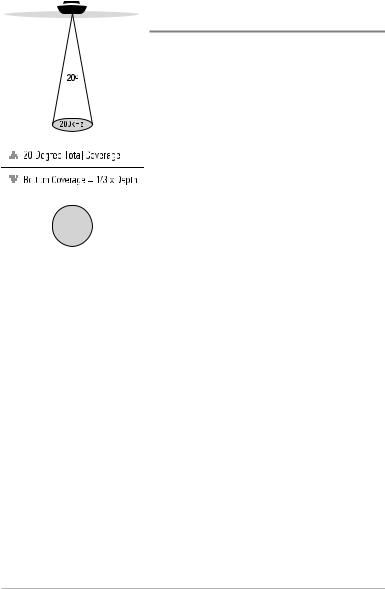
Single Beam Sonar
(550, 560)
The 550 Fishfinder and 560 Fishfinder use a 200 kHz single beam sonar system with a 20° area of coverage. Depth capability is affected by such factors as boat speed, wave action, bottom hardness, water conditions, and transducer installation.
4 |
How Sonar Works |

DualBeam PLUS™ Sonar (561, 570)
The 561 Fishfinder and 570 Fishfinder use a 200/83 kHz DualBeam PLUS™ sonar system with a wide (60°) area of coverage. DualBeam PLUS™ sonar has a narrowly focused 20° center beam, surrounded by a second beam of 60°, expanding your coverage to an area equal to your depth. In 20 feet of water, the wider beam covers an area 20 feet wide.
DualBeam PLUS™ sonar returns can be blended together, viewed separately, or compared side- by-side. DualBeam PLUS™ is ideal for a wide range of conditions - from shallow to very deep water in both fresh and salt water. Depth capability is affected by such factors as boat speed, wave action, bottom hardness, water conditions, and transducer installation.
How Sonar Works |
5 |

Down Imaging™ Sonar
(561 DI, 570 DI, and 571 HD DI)
The 561 DI, 570 DI, and 571 HD DI Fishfinders use Down Imaging™ technology. The Down Imaging™ transducer scans the water with razor-thin, high-definition beams. The beams are wide (side to side) but very thin front to back.
|
The Down Imaging™ beams can be operated |
|
75 Degree Total Coverage |
at two frequencies: 455 kHz (75°) or 800 kHz |
|
(45°). Select 455 kHz for the best overall |
||
|
||
|
||
|
image quality and depth. Select 800 kHz for |
|
|
the sharpest image. See Sonar Menu Tab: |
|
|
Imaging Frequency for more information. |
The transducer also uses conical beams to provide data in traditional 2D format (see
What’s on the Sonar Display). Select 455 kHz for a narrowly focused 16° center beam, or select 200 kHz for a wider 25° beam (see
Sonar Menu Tab: Beam Select).
Depth capability is affected by such factors as boat speed, wave action, bottom hardness, water conditions, and transducer installation.
6 |
How Sonar Works |

What’s on the Sonar Display
The 500 Series™ Fishfinder can display a variety of useful information about
Depth - (water depth) can be set to alarm when the water becomes too shallow.
Temperature - Water surfacetemperature.
Timer - Elapsed time with Temp/Speed
Accessory.
Distance - Distance traveled with Temp/Speed
Accessory.
Average Speed - Average speed reading with
Temp/Speed Accessory.
Second Sonar Return - When the sonar signal bouncesbetweenthebottomand thesurface ofthe water and backagain. Use the appearance of the second returnto determine bottomhardness. Hard bottomswillshowa strongsecondreturn,whilesoft bottomswillshowa veryweakone ornoneat all.
Speed - If a Temp/Speed accessory is attached, the Fishfindercan display the speed of the boat and can keep a Triplog of nautical or statute miles traveled.
NOTE:Entriesin this view that list (with Temp/Speed)are availableif the accessoryis connected
What’s on the Sonar Display |
7 |

the area under your boat, including the following items:
Bait Ball
Hollow Fish Symbol (see Fish ID+™)
Thermoclines - Layers of water with different temperatures that appear at different depths and different times of the year. A thermocline typically appears as a continuous band of gray levels moving across the display at the same depth.
Structure - Where fish may be hiding.
Fish - The Fishfinder displays fish as arches and/or fish icons, and can be set to alarm when a fish of a certain size is detected. When a target is detected, a Fish ID+™ symbol appears on the display with the depth displayed above it. The size of the symbol indicates the intensity of the sonar return. The unit will clearly show schools of Bait Fish as "clouds" of different shapes and sizes, depending on the number of fish and boat speed.
Shaded Fish Symbol (see Fish ID+™)
 RTS (Real Time Sonar) Window™
RTS (Real Time Sonar) Window™
Battery Voltage - The voltage of the boat’s battery; can be set to alarm if the voltage falls below a certain point.
to the 500 Series™ Fishfinder.
8 |
What’s on the Sonar Display |

Understanding the Sonar Display
It is important to understand the significance of the display. The display does not show a literal 3-dimensional representation of what is under the water. Each vertical band of data received by the control head and plotted on the display represents something that was detected by a sonar return at a particular time. As both the boat and the targets (fish) may be moving, the returns are only showing a particular segment of time when objects were detected, not exactly where those objects are in relation to other objects shown on the display.
The returned sonar echoes are displayed on the screen. As a new echo is received, the historical data scrolls left across the view.
Real Time Sonar (RTS™) Window
A Real Time Sonar (RTS™) Window appears on the right side of the display in the Sonar View only. The RTS Window™ updates at the fastest rate possible for depth conditions and shows only the returns from the bottom, structure, and fish that are within the transducer beam. The RTS Window™ plots the depth and intensity of a sonar return (see Sonar Menu Tab: RTS Window™).
The Narrow RTS Window™ indicates the sonar intensity through the use of grayscale. The grayscale used matches the Bottom View grayscale setting (Inverse,StructureID®, WhiteLine™, Bottom Black). The depth of the sonar return is indicated by the vertical placement of the returnon the display depth scale.
The Wide RTS Window™ indicates the sonar intensity through the use of a bar graph. The length of the plotted return indicates whether the return is weak or strong. The depth of the sonar return is indicated by the vertical placement of the return on the display depth scale. The Wide RTS Window™ does not use grayscale.
What’s on the Sonar Display |
9 |
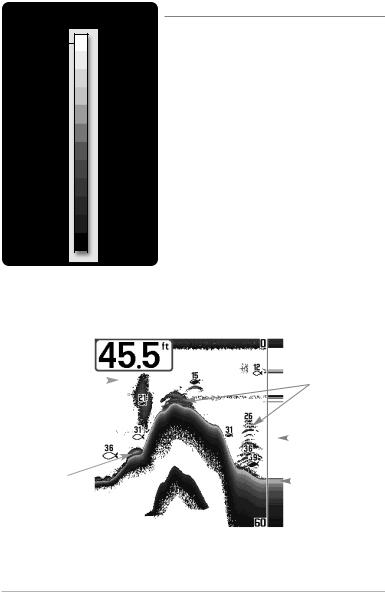
Sonar Returns and Bottom View
Bottom View, Inverse Palette
As the boat moves, the unit charts the
HIGH changes in depth on the display to create a
Intensity Return
profile of the Bottom Contour. The Sonar View displays the sonar return intensity using gray scale.
|
|
|
|
|
|
|
Strong returns often result from rocky or |
||||
MEDIUM |
|
|
|
|
|
|
hard bottoms (compacted sediment, rocks, |
||||
|
|
|
|
|
|
fallen trees), while weaker returns often |
|||||
Intensity Return |
|
|
|
|
|||||||
|
|
|
|
|
|
|
result from soft bottoms (sand, mud), |
||||
|
|
|
|
|
|
|
vegetation, and small fish. |
||||
|
|
|
|
|
|
|
The shades used to represent high, medium, |
||||
LOW |
|
|
|
|
|
|
to low intensity returns are determined by |
||||
|
|
|
|
|
|
the setting you choose in the Bottom View |
|||||
|
|
|
|
|
|
||||||
Intensity Return |
|
|
|
|
|||||||
|
|
|
|
menu option. See Sonar X-Press™ Menu to |
|||||||
|
|
|
|
|
|
|
|||||
|
|
|
|
|
|
|
set the Bottom View. |
||||
|
|
|
|
|
|
|
Sonar View: |
||||
|
|
|
|
|
|
Bottom View set to Inverse (default setting) |
|||||
Sonar History: |
|
|
|
|
|
|
|
|
Weak Returns |
||
|
|
|
|
|
|
|
|
||||
Historical Returns |
|
|
|
|
|
|
|
|
|
||
scroll left across |
|
|
|
|
|
|
|
|
|
(possibly |
|
|
|
|
|
|
|
|
|
vegetation or |
|||
the view. |
|
|
|
|
|
|
|
|
|||
|
|
|
|
|
|
|
|
small fish) |
|||
|
|
|
|
|
|
|
|
|
|
|
|
Strong Returns |
|
|
|
|
|
|
|
|
RTS Window™ |
||
|
|
|
|
|
|
|
|
||||
|
|
|
|
|
|
|
|
|
|||
(possibly rocks, |
|
|
|
|
|
|
|
|
Strong Return |
||
tree limbs, or |
|
|
|
|
|
|
|
|
|||
|
|
|
|
|
|
|
|
||||
|
|
|
|
|
|
|
|
(possibly |
|||
other structure) |
|
|
|
|
|
|
|
|
|||
|
|
|
|
|
|
|
|
compacted |
|||
|
|
|
|
|
|
|
|
|
|
|
|
|
|
|
|
|
|
|
|
|
|
|
sediment or |
|
|
|
|
|
|
|
|
|
|
|
rocks) |
10 |
What’s on the Sonar Display |

Inverse is a method where weak returns are shown with dark pixels and strong returns with lighter pixels. This has the benefit of ensuring that weak signals will be clearly visible on the display.
Structure ID® represents weak returns as light pixels and strong returns as dark pixels. This has the benefit of ensuring that strong returns will be clearly visible on the display.
WhiteLine™ highlights the strongest sonar returns in white resulting in a distinctive outline. This has the benefit of clearly defining the bottom on the display.
Black (Bottom Black) displays all pixels below the bottom contour as black, regardless of signal strength. This has the benefit of providing a high contrast between the bottom and other sonar returns on the display.
What’s on the Sonar Display |
11 |

SwitchFire™
SwitchFire™ controls how the sonar returns are displayed in the Sonar Views. SwitchFire™ settings are available in the Sonar Menu Tab.
To see the maximum sonar information available within the transducer beam so more fish arches and better jig tracking are shown, choose Max Mode.
To see less clutter and more fish size accuracy interpreted from the transducer beam, choose Clear Mode. See Sonar Menu Tab: SwitchFire™ for more information.
Freeze Frame and Active Cursor
Freeze Frame and Active Cursor - Press any arrow on the 4-WAY Cursor Control key, and the screen will freeze and a cursor will be displayed. Use the 4-WAY Cursor Control key to move the cursor over a sonar return, and the depth of the sonar return will be displayed in the cursor dialog box.
The RTS Window™ continues to update in Freeze Frame. To return to a scrolling display and exit Freeze Frame, press the EXIT key. Freeze Frame is available in the Sonar, Split Sonar, and Sonar Zoom Views.
Instant Image Update
Instant Image Update - You can change a variety of sonar menu settings (such as Sensitivity or Upper Range), and the adjustments will be shown instantly on the screen.
12 |
What’s on the Sonar Display |
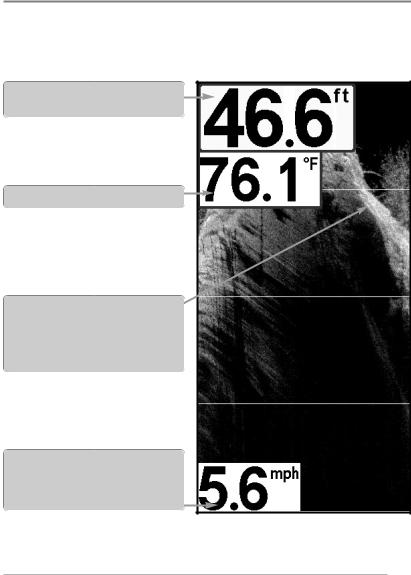
What’s on the Down Imaging™ Display
Down Imaging™ uses its unique transducer and sonar technology to provide profiling beams produce the detailed sonar data that you see on the display. interpret the structure and bottom contour, including the following items:
Depth - (water depth) can be set to alarm when the water becomes too shallow.
Temperature - Water surfacetemperature.
Topography Changes - The light part of the display shows where the beam is hitting hard bottom or rising terrain. The dark part of the display indicates soft bottom (sand, mud) or descendingterrain.
Speed - If a Temp/Speed accessoryis connected, the Fishfindercan display the speed of the boat and can keep a Triplog of nautical or statute miles traveled.
NOTE: Entries in this view that list (with Temp/Speed)are available if the accessory is connected
What’s on the Down Imaging™ Display |
13 |

(Down Imaging™ models only [561 DI, 570 DI, and 571 HD DI])
information about the area directly below your boat. The razor-thin, high-definition Down Imaging™ reveals a variety of recognizable features so that you can
Upper Range
Structure
Clouded Area may indicate a bait ball and
White Streaks may indicate fish.
Shadows - Result from a lack of reflected sonar from a particular area and can be as valuable for interpretation than the sonar reflected by the object itself. Use shadows to help you see the image in 3 dimensions, oriented in space. You can gain insight into the actual shape of an object, or the depth to which it has sunk into the bottom, through shadows on the display. Objects standing on the bottom cast a sonar shadow. The longer the shadow, the taller the object. Fish also cast shadows. You can use the shadow to interpret how close the fish is to the bottom.
Bottom Return - Use the appearance of the bottom return to determine bottom hardness. Rock and gravel provide a clearer sonar return than mud and sand because hard objects reflect sonar better than soft objects.
Lower Range
to the 500 Series™ Fishfinder.
14 |
What’s on the Down Imaging™ Display |
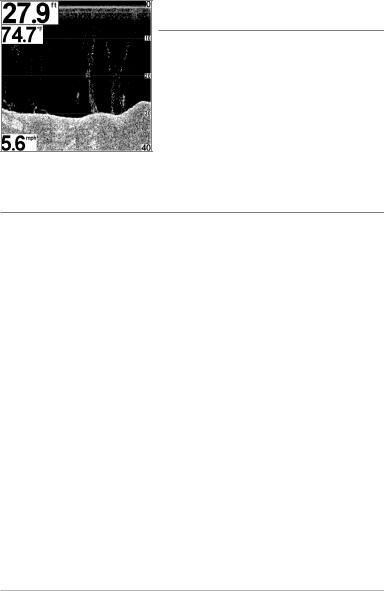
Understanding the
Down Imaging™ Display
The images you see on the Down Imaging™ display are produced using sonar technology. Each time the unit pings, a strip of data representing all the echoes received by the transducer are put together on the display to form the image that you see. Like traditional 2D Sonar, the sonar history scrolls left across the screen.
Interpreting the Display
Down Imaging™ beams “illuminate” the bottom contour, structure, and fish. The beams are wide (side to side) but very thin front to back.
Use the light and dark parts of the display to interpret the objects under your boat as follows:
•Dark shades represent soft returns (mud, sand) or descending terrain.
•Light shades represent denser terrain (timber, rocks) or rising terrain. A very hard bottom may appear as white on the display.
•White Streaks or Clouds may represent fish on the display.
•Shadows are not caused by light but by the lack of a sonar return. Objects standing on the bottom cause a sonar shadow to appear on the display. The longer the shadow, the taller the object. Fish may also cast shadows. You can use the shadow to interpret where the fish or object is located in relation to the bottom.
What’s on the Down Imaging™ Display |
15 |

Down Imaging™ Sensitivity
Use Imaging Sensitivity to control how the sonar returns appear on the display. Increase the sensitivity to reveal weaker returns that may be of interest, especially in very clear water or greater depths. Decrease the Imaging Sensitivity to eliminate the clutter from the display that is sometimes present in murky or muddy water. See Down Imaging™ X-Press™ Menu: Imaging
Sensitivity or Down Sensitivity for more information.
Freeze Frame and Active Cursor
Freeze Frame and Active Cursor - Press any arrow on the 4-WAY Cursor Control key, and the screen will freeze and a cursor will be displayed. Use the 4-WAY Cursor Control key to move the cursor over a sonar return, and the depth of the sonar return will be displayed in the cursor dialog box.
16 |
What’s on the Down Imaging™ Display |

Views
The sonar information from your Fishfinder is displayed on the screen in a variety of easy-to-read views. There are many views available on your Fishfinder.
•Default View: When you first power up the 550, 560, 561, or 570 control head, Sonar View will be the default view. When you first power up the 561 DI, 570 DI, or 571 HD DI control head, Down Imaging™ View will be the default view.
•Cycle: When you press the VIEW key repeatedly, the display cycles through the available views on your screen. When you press the EXIT key, the display cycles through the available views in reverse order.
•Customize: You can display or hide any view to suit your fishing preferences. See the following pages for more information about each view.
NOTE: When you change any menu settings that affectthe sonar,the view will update immediately. You don't have to exit the menu to apply the change to the screen.
Views |
17 |

To customize your view rotation:
You can choose which views are hidden or visible in your view rotation.
1.Press the MENU key twice to access the tabbed Main Menu, then press the RIGHT Cursor key until the Setup tab is selected.
2.Press the DOWN Cursor key to highlight Select Views, and press the RIGHT Cursor key to access the Select Views submenu.
NOTE: If the Select Views option does not appear under the Setup tab, change the User Mode to Advanced.
3.Press the UP or DOWN Cursor keys to select a View.
4.Press the LEFT or RIGHT Cursor keys to change the status of the view from Hidden to Visible or vice versa.
To change the Digital Readouts:
Each view displays digital readout information (such as speed or time), which varies with the view selected and the accessory attached. The digital readouts on the Sonar View can be customized. See Setup Menu Tab: Select Readouts for more information.
1.Press the MENU key twice to access the tabbed Main Menu, then press the RIGHT Cursor key until the Setup tab is selected.
2.Press the DOWN Cursor key to highlight Select Readouts, and press the RIGHT Cursor key to access the Select Readouts submenu.
NOTE: If the Select Readouts option does not appear under the Setup tab, change the User Mode to Advanced.
3.Press the UP or DOWN Cursor keys to select a Readout position, then press the RIGHT or LEFT Cursor keys to choose what will be displayed in that position. To hide the data window, select Off.
18 |
Views |
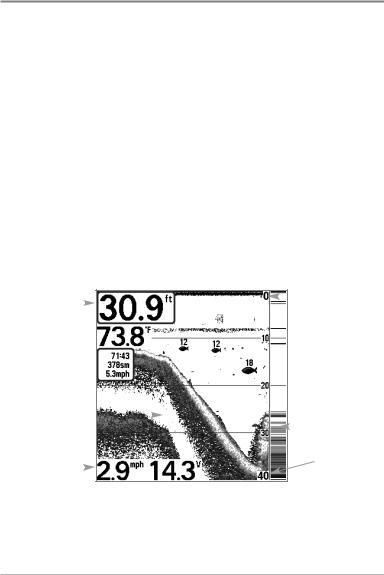
Sonar View
Sonar View presents a historical log of sonar returns. The most recent sonar returns are charted on the right side of the display. As new information is received, the historical information scrolls left across the display.
•Upper and Lower Depth Range numbers indicate the distance from the surface of the water to a depth range sufficient to show the bottom.
•Depth is automatically selected to keep the bottom visible on the display, although you can adjust it manually as well (see Sonar X-Press™Menu).
•Digital Readouts shown on the display will change based on the Select Readouts settings or the optional-purchase accessories attached (see
Setup Menu Tab: Select Readouts).
•Freeze Frame - Use the 4-WAY Cursor Control key to freeze the display and move the cursor over a sonar return. The depth of the sonar return will be displayed at the bottom of the screen in the cursor information box.
Sonar View
Depth |
|
|
|
Upper Depth |
|
|
|
||
|
|
|
Range |
|
|
|
|
|
Temperature 
Triplog 
Sonar History |
|
|
|
|
|
|
|
|
|
|
|
|
|
Window |
|
|
|
|
|
RTS Window™ |
|
|
|
|
|
||
Speed |
|
|
|
|
|
Lower Depth |
|
|
|
|
|
Range |
|
|
|
|
|
|
|
NOTE: If the Depth number is flashing, it means that the unit is havingtroublelocating the bottom. This usually happens if the water is too deep, the transduceris out of the water,the boat is moving too fast, or for any other reason that the unit can’t accurately receive continuous data.
Views |
19 |

Sonar Zoom View
Sonar Zoom View provides a magnified view of the bottom and structure. The Sonar Zoom View makes it easier to see separate sonar returns that would usually be displayed close together, such as those caused by fish suspended close to the bottom or within structure.
•The Zoom Level, or magnification, is displayed in the lower left corner of the display. Press the MENU key once to access the Sonar X-Press™ Menu and use Zoom Level to adjust the zoom settings.
•The Zoomed View is displayed on the left side of the screen. As the depth changes, the zoomed view updates automatically.
•The Full Range View is displayed on the right side of the screen. The Full Range View includes the Zoom Preview Box, which shows where the zoomed view is in relation to the full range view.
•The Upper and Lower Depth Range numbers indicate the high and low range of the water which is being viewed.
Sonar Zoom View
 Upper Depth Range,
Upper Depth Range,
Full Range View
Depth
|
|
|
|
|
|
|
|
|
|
Upper Depth Range, |
|
|
|
|
|
|
|
|
|
|
Zoom View |
Zoomed View |
|
|
|
|
|
|
|
|
Full Range View |
|
|
|
|
|
|
|
|
|
|||
|
|
|
|
|
|
|
|
|
|
|
|
|
|
|
|
|
|
|
|
|
Zoom Preview Box |
|
|
|
|
|
|
|
|
|
||
|
|
|
|
|
|
|
|
|
|
Lower Depth Range, |
|
|
|
|
|
|
|
|
|
|
Zoom View |
Zoom Level |
|
|
|
|
|
|
|
|
|
Lower Depth Range, |
|
|
|
|
|
|
|
|
|
||
|
|
|
|
|
|
|
|
|
|
Full Range View |
|
|
|
Digital depth is displayed in the upper left hand corner. The |
|||||||
|
|
|
digital readouts in the Sonar Zoom View cannot be |
|||||||
|
|
|
customized; therefore, information such as water temperature |
|||||||
|
|
|
and voltage are unavailable in the Sonar Zoom View. |
|||||||
20 |
Views |

Split Sonar View
(DualBeam PLUS™ and Down Imaging™ models only [561, 570, 561 DI, 570 DI, & 571 HD DI])
Split Sonar View displays sonar returns from each down beam frequency on separate sides of the screen. You can use the Split Sonar View to make side by side comparisons between the sonar returns from both beams.
•DualBeam PLUS™ models (561, 570) display sonar returns from the 83 kHz wide beam on the left side of the screen and sonar returns from the 200 kHz narrow beam on the right side of the screen.
•Down Imaging™ models (561 DI, 570 DI, 571 HD DI) display sonar returns from the 455 kHz narrow beam on the left side of the screen and sonar returns from the 200 kHz wide beam on the right side of the screen.
•Depth is displayed in the upper left hand corner.
•The Digital Readouts in the Split Sonar View cannot be customized; therefore, information such as water temperature and voltage are unavailable in the Split Sonar View.
|
|
|
570 DI Split Sonar View |
||||
|
|
|
|
|
|
|
|
|
|
|
|
|
|
|
Upper Depth |
|
|
|
|
|
|
||
Depth |
|
|
|
|
|
|
Range |
|
|
||||||
|
|
|
|
|
|
|
|
 200 kHz Sonar
200 kHz Sonar
History Window
455 kHz Sonar
History Window
Lower Depth
Range
Views |
21 |
